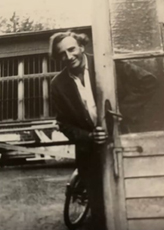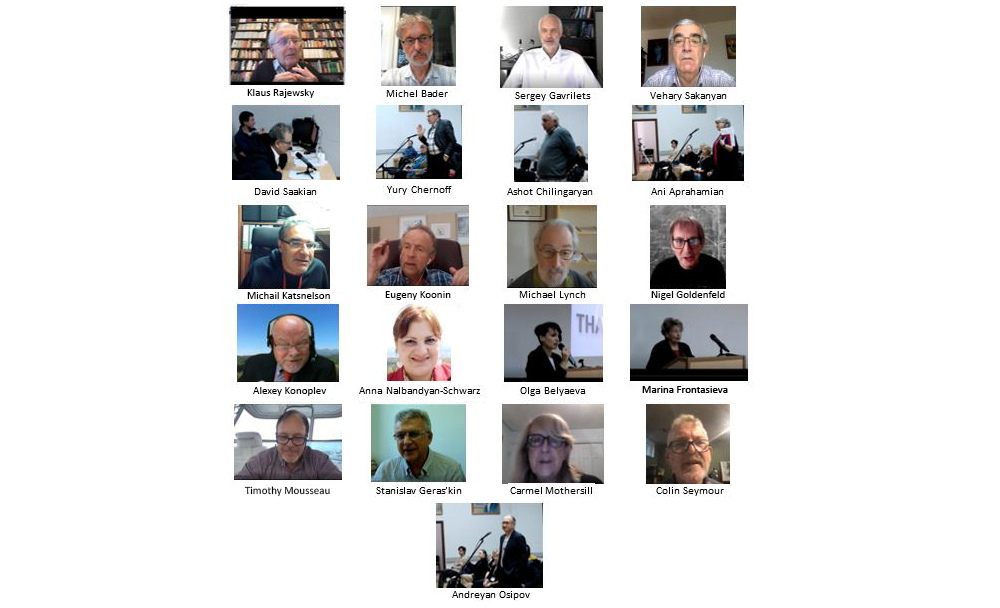Modern problems of genetics, radiobiology, radioecology, and evolution
News, 19 October 2021

Discoveries made by N. V. Timofeev-Ressovsky will become steps in research, but his humanistic principles will always be relevant.
D. A. Granin
Despite the disunity of people and countries in the year of the pandemic, the founders of the conference “Modern problems of genetics, radiobiology, radioecology, and evolution” dedicated to N. V. Timofeev-Ressovsky and his scientific school – Russia, Armenia, Ukraine, Belarus, and Germany — organized a regular symposium, moving it from the crowded city of Yerevan to the Nor-Amberd mountain space station. The Scientific Secretary of the Conference V. L. Korogodina comments on the event.
It was important to keep the tradition of holding the event, because Timofeev-Ressovsky’s scientific school determines not only the direction of research but also scientific and life ethics. A kind of greeting from Berlin-Buch was a story by Klaus Rajewsky (Berlin-Buch, Germany) about Nikolay Vladimirovich.
The key organizers of the conference were JINR and AANL (YerPhI); the sponsors were the GSI Helmholtz Centre in Berlin-Buch and Darmstadt and the Institute of Industrial Ecology of the Ural Branch of RAS. Victor Matveev (JINR), Ani Aprahamyan, and Ashot Chilingaryan (AANL) not only chaired the organizing committee but also were participants of the conference. The main organiaers were Victoria Korogodina and Arpine Piloyan. But the most important person for the event was Nikolay Smirnov who installed, set up, and constantly regulated the online connection of the conference. Students of Yerevan State University also helped to organize the meeting.
The conference was held in a hybrid format. The organizers regret for being unable to communicate with many colleagues personally, but online events also have their advantages. A large collection of online lectures, which would have never been given at the conference all in person, was compiled. The programme of the meeting included plenary, oral, and poster reports. There were lectures for students at Yerevan State University, scientific excursions, oral talks by young scientists and the publication of their works, sightseeing. An atmosphere of friendship prevailed in spite of sometimes vigorous scientific debates.
The description of separate processes of Timofeev-Ressovsky’s time by scientists nowadays has been replaced by the study of constantly and rapidly changing complex structures. In the section “Genetics”, the participants heard reports on the genome universe (Eu. V. Koonin, USA), the systems of processes influencing the formation and distribution of proteins (Yu. O. Chernoff, Russia, USA; A. A. Nizhnikov, Russia), and directed mutagenesis (E. K. Khlestkina, Russia). Applied research in the fields of medical genetics was presented by scientists from Germany (M. Bader, R. Zinzen), France (V. Sakanyan), and Belarus (I. B. Mosse). Armenian geneticists have shown the results of the study of the effects of toxic substances and mutagens on cells (R. M. Arutyunyan, Armenia; A. Sargsyan, Armenia). Genetics research at JINR was presented by K. Afanasyeva (DLNP).
In the section “Radiobiology”, the multiplicity of mechanisms of influence and the ambiguity of response were highlighted in the reports by scientists from Canada C. Mothersill and C. Seymour, destabilization of the genome in generations was shown (Yu. Dubrova, UK), as well as the dependence of the cell reaction on the radiation regime (A. Osipov, Russia). G. Tsakanova (Armenia) spoke about the use of ultra-short laser technology in medicine. Reports on radiation medicine were presented by JINR staff members N. Zhuchkina (LRB), A. G. Molokanov, A. V. Rzyanina, and S. V. Shvidkij (DLNP).
Radioecologists described anthropogenic sources of radiation and the ways in which radionuclides are distributed (A. V. Konoplev, Japan; A. Nalbandyan-Schwarz, Norway), their effects on populations (S. A. Geras’kin, Russia) and ecosystems (T. Mousseau, USA), including humans (A. V. Korsakov, Russia). A. Chilingaryan (AANL, Armenia) spoke about the increase in the natural background of gamma radiation during a thunderstorm, and N. Movsisyan (CENS, Armenia) made a presentation on the distribution of radionuclides and ecological risks in Armenia. M. V. Frontasyeva (FLNP JINR) elaborated on the definition of the accumulation of radionuclides in mosses and the observation of their accumulation worldwide.
The section “Evolution” included reports from different fields of biology in which evolution is explicitly or implicitly related to the development of the system complexity. From physical point of view, this idea was presented by M. Katsnelson (Netherlands), which immediately sparked lively debate; the relationship between evolution and thermodynamics was discussed in D. Saakyan’s report (AANL, Armenia). Scientists presented papers on the evolution of viruses (Eu. V. Koonin, USA), replication and transcription mechanisms (M. Lynch, USA), ecosystems (N. Goldenfeld, USA). Reports were made on the origin of life (A. Mulkijanyan, Russia, Germany) and human, on social laws (S. Gavrilets, USA). A. Chilingaryan (AANL, Armenia) presented a method of random search in evolutionary biology and population genetics.
Lectures on biology and physics were organized for students and young scientists at Yerevan State University. Lectures on biology were given by M. Lynch, E. K. Khlestkina, T. Mousseau, Eu. Koonin, C. Mothersill, C. Seymour, and S. Gavrilets. V. A. Matveev spoke about research at JINR, and V. A. Nikitin reported on elementary particles. The lectures were broadcast to the institutions in different countries. University lectures and conference plenary reports will be published on the Internet, and the link will be available on the websites of the conference, JINR, AANL, and YSU. Students and young scientists from different countries delivered their reports at the conference, and their short articles will be published at JINR.
The Organizing Committee and Rossotrudnichestvo in Armenia organized scientific excursions to the Aragats upper space station (AANL) and the Laboratory of the Armenian Nuclear Power Plant in Metsamor on radiation protection of the environment. At Aragats, A. Chilingaryan spoke about the station’s history, research, and gamma showers during storms. B. E. Shtern participated in the discussion. The Head of the Laboratory of the NPP K Pyuskyulyan spoke about regular monitoring of radiation level in the 30-km area of the station and other regions of Armenia, which is performed by the Laboratory staff and CENS. Excursions were organized to Matenadaran and Lake Sevan. Conference participants were particularly pleased with Armenian cuisine, music, and dance.
The organizers are grateful to V. A. Matveev, A. Aprahamyan, and A. Chilingaryan for their support and personal participation in the conference; A. Piloyan and her large team of AANL staff and young volunteers; engineers of JINR and AANL for setting up the Yerevan — Nor- Amberd radio bridge and personally to N. V. Smirnov, as well as to V. M. Pushkina for the wonderful conference website. Lectures at Yerevan State University would not be possible without the help of E. Dalyan and students of A. Mikaelyan, A. Ayrapetyan and A. Gevorgyan.
JINR Weekly Newspaper on the conference in Nor-Amberd: Day one. Genetics
JINR Weekly Newspaper on the conference in Nor-Amberd: Day two. Radiobiology
JINR Weekly Newspaper on the conference in Nor-Amberd: Day three. Radioecology
JINR Weekly Newspaper on the conference in Nor-Amberd: Day four. Evolution

